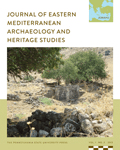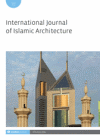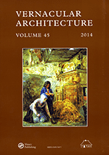
TRANSACTIONS OF THE ANCIENT MONUMENTS SOCIETY
Scope & Guideline
Illuminating the Intersection of History and Preservation
Introduction
Aims and Scopes
- Architectural History and Heritage Conservation:
The journal emphasizes the importance of understanding architectural styles and their historical contexts, focusing on significant structures and their preservation efforts. - Cultural and National Identity in Architecture:
It examines how architectural styles reflect and shape cultural identity, particularly in relation to national narratives and historical events. - Interdisciplinary Approaches to Monument Studies:
The journal encourages interdisciplinary methodologies, incorporating art history, archaeology, and cultural studies to provide a comprehensive view of ancient monuments. - Regional Studies of Architectural Significance:
There is a consistent focus on regional studies that delve into the architectural heritage of specific locales, such as Scotland and Ireland, and their unique contributions to the broader architectural landscape. - Documentation and Archival Research:
The journal values the importance of documentation, including surveys and archival studies, to enhance the understanding of historical buildings and their significance.
Trending and Emerging
- Cultural Hybridity and Global Influences:
Recent publications highlight the importance of cultural hybridity in architecture, exploring how global influences shape local architectural practices, as seen in studies of 19th-century Delhi. - Modern Interpretations of Historical Architecture:
There is an increasing trend towards analyzing modern responses to historical architecture, focusing on contemporary interpretations and adaptations of ancient styles. - Impact of Architecture on Identity and Memory:
Emerging themes examine how architecture contributes to collective memory and identity, reflecting societal changes and historical narratives through the lens of built heritage. - Environmental and Social Contexts of Architecture:
Recent works emphasize the importance of environmental and social contexts in understanding architectural significance, advocating for studies that incorporate these elements into heritage conservation. - Interwar and Modern Architectural Movements:
The journal is seeing a rise in interest regarding interwar architectural movements, particularly Art Deco, as scholars explore their implications for modern identity and cultural expression.
Declining or Waning
- Traditional Architectural Styles:
There seems to be a waning interest in purely traditional architectural styles without a contextual or cultural analysis, as more recent papers lean towards interdisciplinary studies that incorporate broader themes. - Narrow Geographical Focus on Britain:
While British architecture remains a significant area, there is a noticeable reduction in papers that focus exclusively on local British monuments without considering their global or comparative significance. - Biographical Studies of Historical Figures:
The focus on individual biographies of historical architects or figures is less prevalent, as the journal increasingly favors thematic and broader architectural studies over singular narratives.
Similar Journals

Journal of Eastern Mediterranean Archaeology and Heritage Studies
Uncovering the Past, Preserving the FutureJournal of Eastern Mediterranean Archaeology and Heritage Studies, published by Penn State University Press, is a premier academic journal dedicated to the exploration and understanding of the archaeological and heritage landscapes of the Eastern Mediterranean region. With an ISSN of 2166-3548 and an E-ISSN of 2166-3556, this journal serves as an essential resource for researchers, professionals, and students in the fields of archaeology, conservation, and heritage studies. Its notable impact is reflected through its Q2 category rankings in both Archaeology and Conservation, coupled with commendable Scopus rankings, positioning it within the top quartiles of its disciplines. The journal not only fosters scholarly dialogue by publishing cutting-edge research but also aims to bridge the gap between academic inquiry and practical conservation efforts. As the field continues to evolve, this journal provides a vital forum for disseminating knowledge and advancing the preservation of cultural heritage, making it indispensable for all engaged in the study of the Eastern Mediterranean’s rich archaeological heritage.

Bulletin KNOB
Illuminating the Intersection of Arts and HeritageBulletin KNOB, published by the KONINKLIJKE NEDERLANDSE OUDHEIDKUNDIGE BOND-KNOB, is a reputable Open Access journal that has been disseminating knowledge since 1899, with a continued commitment to making research accessible to all. Based in the Netherlands, this journal provides a platform for scholarly articles that span the fields of Conservation, History, and the Visual Arts and Performing Arts. With its 2023 Scopus rankings placing it in the top quartiles within its category, Bulletin KNOB is recognized for its significant contribution to the advancement of these disciplines. Researchers, professionals, and students alike are encouraged to engage with the journal's diverse content that bridges historical narratives with contemporary practices, fostering a deeper understanding of cultural heritage. The journal’s commitment to excellence is further reflected in its Q3 and Q4 quartile rankings, making it an essential resource for anyone dedicated to the study of the arts and humanities.

Art-Sanat
Illuminating the Past, Inspiring the Future of ArtArt-Sanat is a distinguished open-access journal published by the Research Institute of Turkology at Istanbul University, focusing on various facets of art history, visual arts, and cultural heritage. Since its open-access launch in 2017, the journal has been dedicated to promoting scholarly communication and disseminating innovative research within the fields of Art History, Archaeology, and Conservation. With an impact factor that highlights its increasing prominence—ranking in the Q1 quartile for History and Visual Arts and Performing Arts—Art-Sanat provides a platform for researchers, professionals, and students to share high-quality studies. The journal's commitment to transparency and accessibility assures that its contributions are available to a global audience, fostering a community of inquiry in the rich and diverse artistic landscapes of Turkey and beyond. With a robust ranking in Scopus, it stands as a noteworthy resource that advances scholarly engagement and interdisciplinary dialogue in the arts and humanities.

International Journal of Islamic Architecture
Fostering Critical Discourse in Global Architectural PracticesThe International Journal of Islamic Architecture, published by INTELLECT LTD in the United Kingdom, is a pivotal scholarly resource dedicated to the exploration of Islamic architecture, design, and cultural expressions within a contemporary framework. With ISSN 2045-5895 and E-ISSN 2045-5909, this journal targets an interdisciplinary audience by bridging the gap between architecture, geography, urban studies, and the arts. Established in 2012, it has swiftly garnered recognition, achieving notable rankings such as Q3 in Architecture and Q2 in Visual Arts and Performing Arts by 2023. Although it currently does not offer open access, its articles are meticulously peer-reviewed, ensuring high academic standards and relevance. Emphasizing the significance of Islamic architectural heritage in global contexts, the journal seeks to foster innovative perspectives and critical discourse, making it an essential platform for researchers, professionals, and students alike to engage with contemporary architectural practices and cultural dialogues.

Ra-Revista de Arquitectura
Challenging conventions, inspiring creativity.Ra-Revista de Arquitectura is an esteemed open-access journal published by UNIV NAVARRA, SERVICIO PUBLICACIONES in Spain, dedicated to the fields of architecture and the visual arts. With an ISSN of 1138-5596 and an E-ISSN of 2254-6332, this journal aims to foster a critical dialogue among scholars, practitioners, and students by offering original research, reviews, and case studies that challenge conventional architectural paradigms and inspire innovation. Since transitioning to an open-access model in 2012, Ra has expanded its reach, allowing free access to knowledge that resonates within both academic and professional communities. Although the journal is currently ranked in Q4 in its respective categories, it remains a vital platform for emerging voices and advancements in the architecture and visual arts disciplines. Researchers can find valuable insights that push the boundaries of both theory and practice. The journal is part of a vibrant academic tradition, contributing to a deeply reflective cultural heritage, and it invites contributors from diverse backgrounds to submit their works for consideration.

Zograf
Exploring new dimensions in visual and performing arts.Zograf is a distinguished open-access journal published by the University of Belgrade's Institute of Art History, Faculty of Philosophy, dedicated to the fields of Archeology, History, and Visual Arts and Performing Arts. With an ISSN of 0350-1361 and an E-ISSN of 2406-0755, Zograf has made substantial contributions to research within its domain since transitioning to open access in 2002. Situated in Serbia, the journal has achieved notable recognition, ranking in the Q1 category for both History and Visual Arts and Performing Arts, and in the Q2 category for Archeology in the recent 2023 evaluations. This positioning underscores its significance and influence among peers, making it an invaluable resource for researchers, academics, and students alike. The journal's commitment to disseminating high-quality scholarship facilitates interdisciplinary dialogue and advances knowledge in the humanities, while its open-access model ensures that research is freely available to a global audience. Zograf's editorial board comprises leading scholars who are dedicated to promoting innovative research that inspires future generations of scholars.

Revista Electronica de Fuentes y Archivos
Enhancing Understanding Through Open AccessRevista Electronica de Fuentes y Archivos is a distinguished academic journal dedicated to the exploration of historical sources and archival studies. Published by the CENTRO DE ESTUDIOS HISTORICOS PROF CARLOS S A SEGRETI in Cordoba, Argentina, this journal has been an open-access resource since 2010, ensuring that a diverse audience of researchers, professionals, and students can freely access valuable scholarly work. The journal aims to foster dialogue and dissemination of knowledge within the fields of history, archival science, and documentation studies, promoting interdisciplinary collaboration. With its commitment to enhancing historical inquiry and promoting best practices in archival management, Revista Electronica de Fuentes y Archivos plays a pivotal role in supporting the academic and professional development of those dedicated to the preservation and interpretation of historical records.

Zbornik Matice Srpske za Likovne Umetnosti-Matica Srpska Journal for Fine Arts
Exploring the Depths of Serbian Artistic HeritageZbornik Matice Srpske za Likovne Umetnosti-Matica Srpska Journal for Fine Arts is a prestigious academic journal published by Matica Srpska, dedicated to the study and exploration of fine arts in Serbia and beyond. With the ISSN 0352-6844, this journal serves as a vital platform for researchers, professionals, and students engaged in the visual arts, fostering a rich dialogue on artistic practices, theory, and history. Although currently not an open access publication, it provides invaluable insights into the artistic developments within the Serbian cultural landscape. The journal's commitment to high-quality scholarship is essential in advancing the study of fine arts, ensuring that the contributions reflect the evolving dynamics of artistic expression and cultural heritage. Whether you are a seasoned scholar or an emerging artist, Zbornik Matice Srpske za Likovne Umetnosti invites you to engage with its rigorous research and to contribute to an ever-growing body of knowledge in the realm of fine arts.

REVUE DES MUSEES DE FRANCE-REVUE DU LOUVRE
Cultivating Critical Perspectives on Cultural HeritageREVUE DES MUSEES DE FRANCE-REVUE DU LOUVRE, published by CONSEIL MUSEES NATIONAUX, serves as a vital resource in the fields of Conservation, Museology, and the Visual Arts. With its ISSN 1962-4271 and a dedicated focus on the interplay between historical artifacts and contemporary museum practices, the journal has established itself within the academic community despite its Q4 ranking in various categories as of 2023. The journal is particularly aimed at researchers, professionals, and students who are engaged in the study of museum practices and the preservation of cultural heritage, providing insights and discussions that are both scholarly and practical. Though the journal does not have open access options, it remains a pivotal outlet for innovative ideas and critical perspectives from the vibrant French museum landscape. The issues published since its convergence years from 2009 to 2016 and from 2018 to 2024 continue to foster rich dialogues around the evolving role of museums in society, making it an essential read for anyone invested in the future of cultural institutions.

Vernacular Architecture
Exploring the Essence of Place in ArchitectureVernacular Architecture, published by ROUTLEDGE JOURNALS, TAYLOR & FRANCIS LTD, is a pivotal scholarly journal dedicated to the study and preservation of traditional architectural practices. With its ISSN 0305-5477 and E-ISSN 1749-6292, this esteemed journal has been at the forefront of research from 1971 to 2023, providing a platform for interdisciplinary discourse among architects, historians, and conservationists. The journal holds noteworthy rankings, placing in the Q4 quartile for Architecture and making significant strides in related fields, including Conservation, History, and Visual Arts. As a vital resource with a current Scopus rank of #142 in Visual Arts and Performing Arts, it not only reflects the rich fabric of architectural heritage but also stimulates innovative approaches to contemporary building practices. Although not open access, it remains indispensable for those who wish to explore the nuances of vernacular forms and their cultural significance. Experience the convergence of scholarship and practice in Vernacular Architecture, a journal that champions the essence of place and identity in the built environment.